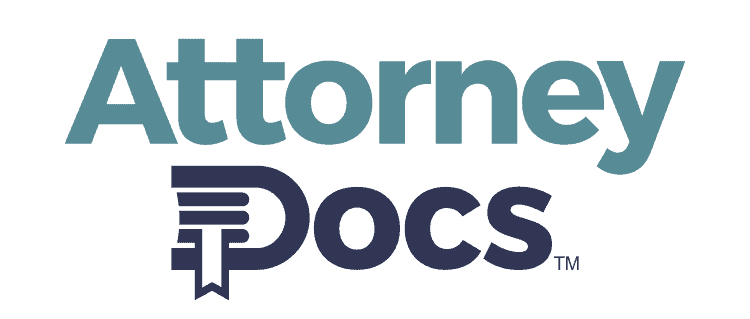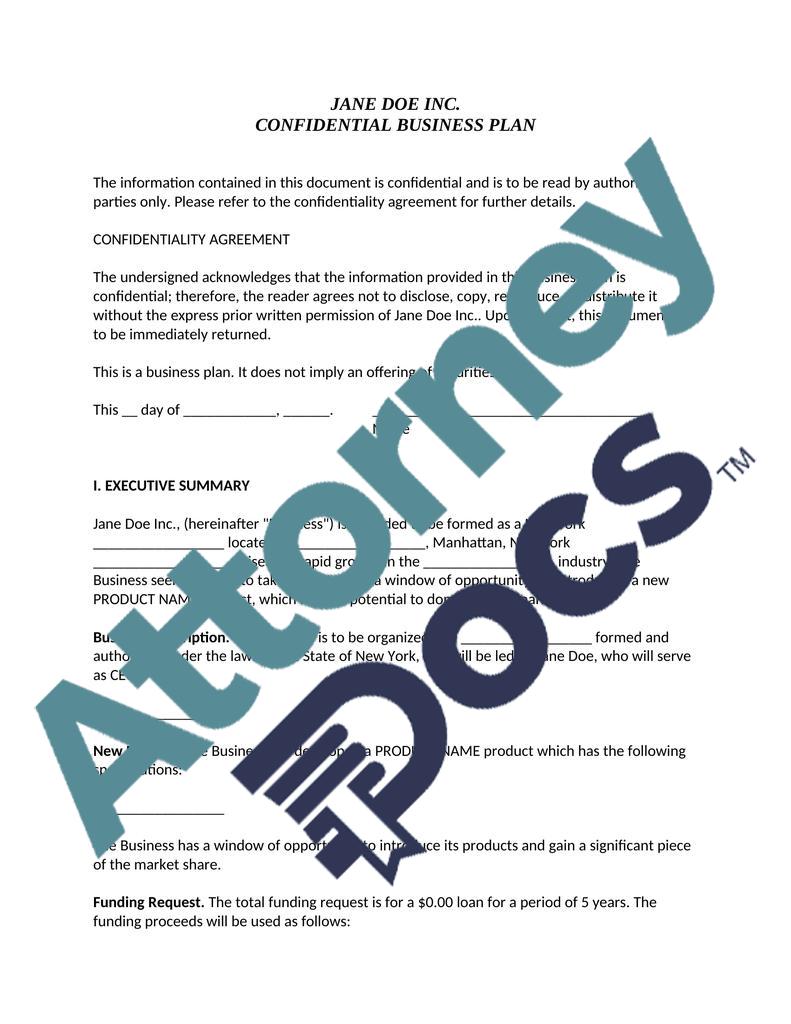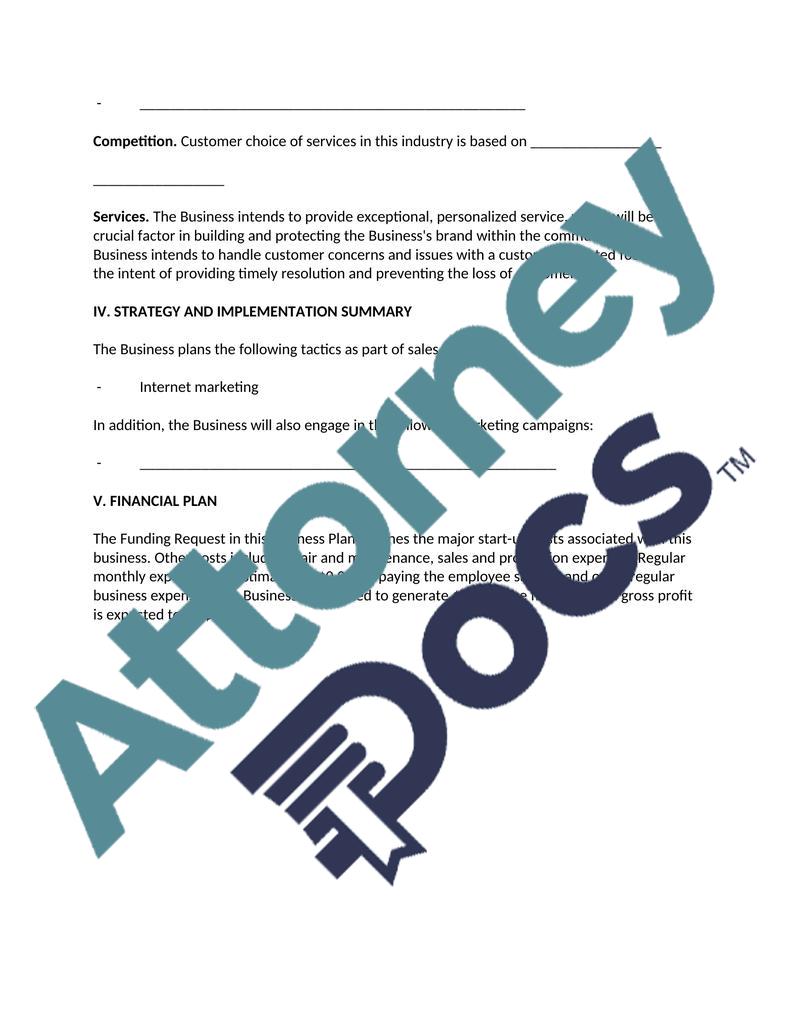Description
In the era of online shopping, marketing, and services, it can seem that starting a business is easier than ever. While that may be true, it’s always better to go in with a plan. A business plan is crucial to the formation of any business. It will help outline your company’s future, which is key to obtaining financing and documenting a business model. Many of the descriptions here reference giving information to potential stakeholders, but a business plan is just as important for your company’s internal purposes. It will document your finances, outline a clear plan for marketing and selling, and serve as a catch-all for business-related documents and information, among other things. One example of a business plan may look like this:
- Executive Summary – This will likely be the last section you write, once you’ve hashed out exactly what you want to include. However, this is the arguably most important section, as it’s what your potential stakeholders will read to determine if they are interested in partnering with your company or even to determine if they are interested in reading further. Most sections in the executive summary are covered in more depth later, so don’t feel like you have to write down every last detail here. Use this section to highlight what you feel to be the most important information.
- Business Description – Much of this information is what you would be able to find on a typical company website, brochure, or flyer. Don’t be afraid to use the same content for both purposes!
- Market Analysis – This section will have research about supply and demand, the target market, the industry, and your competitors. Quite a bit of this information lends itself well to data figures, so including those is a great way to keep the information succinct and readable.
- Product or Service Description – This section will include details about what your specific product or service is. This will likely include a description of the product or service itself, the packaging, how it will be delivered to customers, and quality control procedures.
- Operations and Management Plan – This section will describe what your strategy is for operating your business, including manufacturing, supplies, and sales.
- Financial Plan – This is where to include all the details about your company’s finances. Many of these documents will need to be updated relatively frequently, as they will describe your financial situation at a given point in time.
- Implementation Plan – This section will detail what your strategy is for actually doing all of the things you planned to do earlier in the document. This is also useful for internal purposes in ensuring you are on track to accomplish your goals.
- Appendices – This is where to put all of the information you want to include in your plan but don’t necessarily know where to put it. Extra documentation, legal paperwork, resumes, and any digital or physical copies of intellectual property can all be included here.
You can certainly use a template like this and fill in your information where you think it fits best, but if you are in search of a little more detail, see the template below. Anything listed here is simply a suggestion, as a business plan is completely customizable to your needs. This example includes the same overarching sections, each with a list of items to potentially include and a brief description of said items.
Executive Summary
Business Overview – Always begin with a brief summary of what your business is. Potential stakeholders will definitely want to know the basics of your company. This is also a great blurb to provide to anyone who wants to know about your business or even your website.
Mission and Vision Statement – This is an overarching statement of your primary goal for your company. Again, stakeholders will want to know what your mission is before deciding if they are interested in investing.
Key Objectives – List and briefly describe the key points of what you hope to accomplish.
Products or Services Offered – Detail the products or services that your business offers.
Market Opportunity – Describe the niche in the market that your product or service will fill.
Financial Summary – Give an overview of your financial plans, including a summary of your projected costs and where you plan to get the financing from.
Business Description
Company History – Go over how your company got started and how it became what it is today. Who founded the company? What did it originally offer, and how is that different or the same as what it offers today?
Legal Structure and Ownership – Describe what type of company it is and who owns it. Is it a single-owner or a co-op? How is it registered?
Management Team – Detail the positions that help your company run. Are you the sole manager/owner, or do you have a team in charge? You may include names and a brief description of their experience here as well.
Personnel Plan – Outline your plan for hiring employees and what personnel your company needs to run effectively. Include retail staff, warehouse employees, and factory workers, as well as any delivery drivers or distribution staff you may need to hire.
Intellectual Property – Does your company have any copyrighted or trademarked material? List that in this section.
Market Analysis
Industry Description and Outlook – Detail exactly what industry your company falls under. Is this industry expected to grow, stagnate, or decline? Include numbers as much as you can. This section may need to be updated fairly frequently.
Target Market – Who is your product or service intended for? Give demographic information and discuss how likely people are to purchase it. Include as much detail as possible about your intended consumer.
Competitor Analysis – Who else is offering the same product or service as you? How is yours different/better? It is a good idea to make use of charts to compare and contrast products here.
Marketing and Sales Strategy – Describe how you plan to advertise and sell your product or service. Include pricing information and details about what forms of marketing you plan to use, as well as your plans for getting over any predicted roadblocks.
Financial Summary – Give an overview of your financial plan. Include a breakdown of sales, revenue, profit, expenses, and any other metrics that you think are relevant to your particular company. This should be more detailed than its counterpart in the Executive Summary, but you don’t need to provide as much detail as in the Financial Plan later. Alternatively, you may choose not to include this section at all.
Product or Service Description
Description and Benefits – Why should people purchase your product or service? Describe what it is and how it will solve a problem for the people who buy it. Go into lots of detail here as stakeholders will want to know exactly what you are selling.
Production Process – Detail exactly how your product is made. This may include a production process in a factory, or in your primary retail location, depending on what is offered.
Research and Development – What research has gone into creating this product or service? This is another good place to include data figures.
Operations and Management Plan
Business Location and Facilities – Where is the physical location of your business? Make sure to include office space, warehouses, factories, and stores – whatever is applicable to your specific company.
Technology and Equipment – Detail what equipment is needed to operate your business. This includes manufacturing equipment, marketing technology, and any equipment needed to display or sell your product.
Inventory and Suppliers – Note down what you already have in terms of inventory and what suppliers you may already be contracted with. If needed, detail your plan for reaching out to and contracting new suppliers.
Distribution and Delivery – How will consumers access your product or service? Describe how it will be distributed, including transport from factory to warehouse and warehouse to store, as well as delivery, if applicable.
Quality Control – Note your plan for ensuring a consistent quality of production. Include any inspections, quality checking equipment, and, for services, employee reviews.
Management Team – Go into more detail about your management team. What positions will be considered management, and what exactly will they be in charge of? You may also expound on the managers you named earlier if you like.
Financial Plan
Start-Up Costs and Funding – Where is the money coming from to start the business? This includes overhead, the first materials, initial marketing, and property costs. Are you going to get a business loan?
Projections and Forecasting – Time for some financial analysis! What is predicted to happen to your revenue in the coming years? It is helpful to include data tables, charts, and graphs to make this section easier to read.
Revenue Streams – Detail your sources of revenue, including the percentage you receive from each. This includes revenue directly from sales, revenue from interest, any profit from renting out buildings or equipment, and anything earned on stock dividends.
Profit and Loss Statement – Summarize your revenues, costs, and expenses for a given time period, usually a year. Profit and loss statements are often issued publicly by companies as well as included in their business plans.
Cash Flow Statement – Summarize the cash and cash equivalents that go in and out of your company. This will help stakeholders determine how much cash is available to fund the company.
Balance Sheet – Detail your company’s assets, liabilities, and shareholder equity. This balance sheet will represent a specific point in time, so be sure to include the date and update the document regularly.
Break-Even Analysis – Calculate the number of sales it will take to make back all of the costs you have incurred through production. This helps determine the level of production and your sales mix.
Financial Assumptions – Estimate your company’s future financial performance, including revenue, expenses, and profits. These estimates should be based on historical data, market trends, and your goals and strategies.
Implementation Plan
Milestones and Timeline – Detail what milestones you plan to accomplish and when they will be achieved by. Stakeholders will like to know what the future will look like for the business.
Action Plan – How do you plan to accomplish the aforementioned timeline? Make sure to be realistic, as it will not reflect well on your business if you are not able to achieve your plan.
Risks and Mitigation Strategy – What risks does this action plan have? Detail how you will avoid the risks or reduce their detriments.
Monitoring and Evaluation – This is where to include how you will monitor your progress in terms of your action plan. In addition, describe how you plan to keep an eye on the risks and how you will evaluate if they have been avoided.
Appendices
Marketing Research Data – Include graphics and details from your marketing research.
Legal Documents – This is where to put copyright or trademark paperwork, as well as any other legal documentation you may have for your business.
Resumes of Management Team – Potential stakeholders may like to know more about who they are working with and what experience they have. Include management resumes here to show that you have built a strong team, including your own.
Key Partnerships – If you are partnered with any other companies or any spokespeople, make note of that here.
Marketing Collateral – Include here any digital or printed material your company uses for marketing purposes.
Again, this is just a sample template – anything can be changed to better suit your purposes. Purchase our template that’s created by a certified legal professional. Creating a strong business plan will help your company to run smoothly, secure investors, and maintain documentation. Hopefully, these tips will help you build a plan of your own for any purpose, whether it be starting a new company or maintaining an existing one!
- yes





 Complaint for Maritime Breach of Contract
Complaint for Maritime Breach of Contract  Breach of Contract Failure to Pay
Breach of Contract Failure to Pay  Corporate Bylaws
Corporate Bylaws  Jury Instructions for Breach of Contract
Jury Instructions for Breach of Contract  Trade Secrets JUROR QUESTIONNAIRE
Trade Secrets JUROR QUESTIONNAIRE  Summons Complaint and Cover Sheet - Shareholders Rights
Summons Complaint and Cover Sheet - Shareholders Rights  Answer to Civil lawsuit with counterclaim-Marriage and Divorce
Answer to Civil lawsuit with counterclaim-Marriage and Divorce  Promissory Note - California
Promissory Note - California  60 - Day Past Due Letter
60 - Day Past Due Letter  Employment Contract
Employment Contract  Complaint - Contract
Complaint - Contract  MINUTES OF THE BOARD OF DIRECTORS MEETING
MINUTES OF THE BOARD OF DIRECTORS MEETING